There is a sense of satisfaction in brewing a good cup of coffee at home. The secret to achieving this is buying the right kind of beans. While browsing the coffee aisle, or your local roaster, a whole host of choices are presented. These can be perplexing with coffee terminologies such as “single-origin”, “espresso beans”, “light roast” or “full city.”
If you want to make espresso, do you pick up some espresso coffee beans or regular coffee beans? Reading beyond labels, espresso beans are coffee beans and the packaging label suggests the roaster’s recommendation on how to brew the beans.
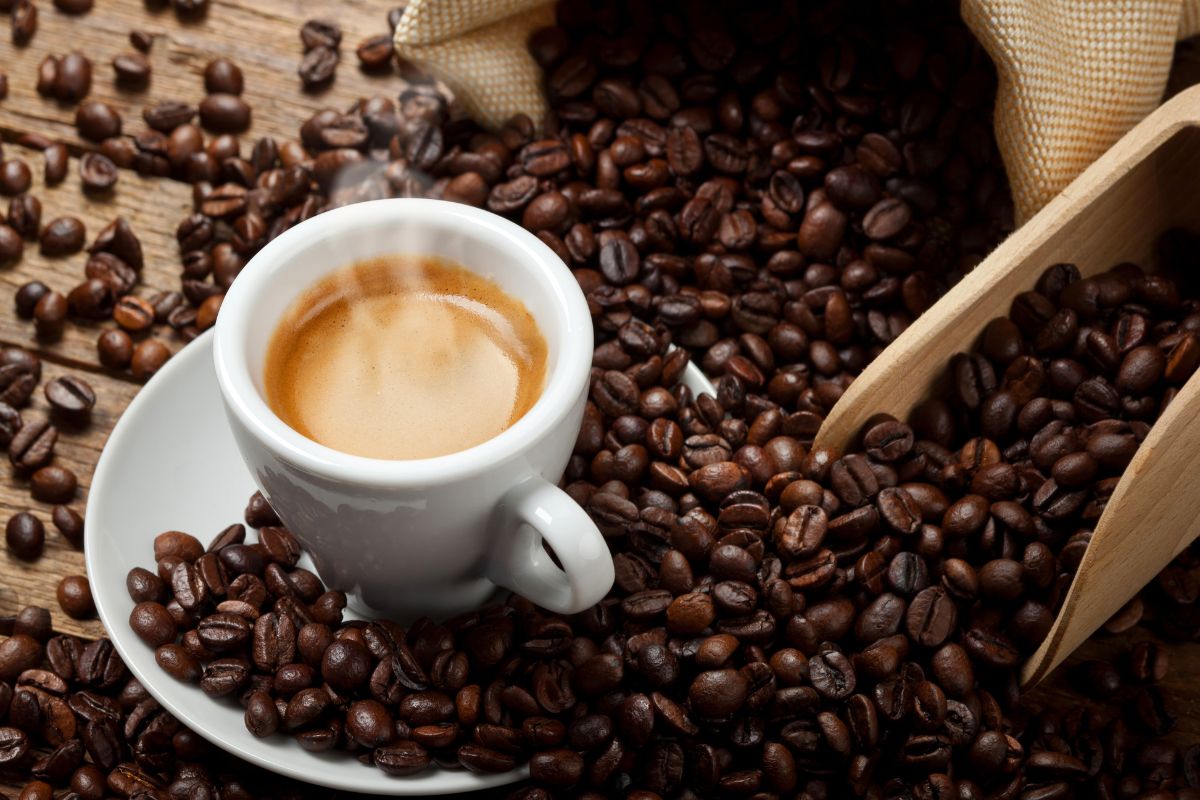
Table of Contents
Espresso Beans vs. Coffee Beans: Basic Differences
Espresso Beans and Coffee Beans come from the same origin – the coffee bean. Coffee beans are either part of the Robusta or Arabica species, with further varietals bred from these two. The main difference between espresso beans and coffee beans lies in the brewing method. Making an espresso and a regular brewed coffee involves different procedures for roasting, grinding, and brewing.
Roasting Beans
Roasting is a process of physical and chemical changes induced by heat. Heat turns green coffee beans into the dark beans we know and recognize. They do this by roasting, which releases the fragrance and flavor that are otherwise locked within the beans. It is the most distinguishing aspect of coffee, in terms of flavor.
Espresso beans are coffee beans that have been roasted to the darkest, and longest roasting point. Espresso beans are roasted at a temperature of 464 degrees Fahrenheit precisely to have that uniformity, body, and flavor for a good espresso shot.
When espresso beans are roasted long enough (moving beyond the second crack), the beans achieve a deeper, more toasted flavor. This process produces more oil, which gives a richer, heavier feel to coffee.
An audible crack is heard when Carbon Dioxide builds up in the bean and its rigid cellular nature becomes more brittle. When the structure shatters, oils from the bean migrate from the inside to the outside. The more oil is released, the more acidity is removed, creating a fuller, more intense flavor in the mouth.
Coffee beans used for regular brews are roasted for a shorter period than espresso beans. Regular coffee beans vary from light roast to medium roast to dark roast. Light roast is heated until the first crack – about 350 – 401 degrees Fahrenheit. It has the least amount of roasting time compared to the other roasts.
Medium roasts are heated slightly longer than light roasts, stopping just before the start of the second crack – about 425 degrees Fahrenheit. There is no surface oil yet because it hasn’t been heated long enough to come out. The acidity is noticeably less than that of the light roast. The dark roast is heated until the second crack, the longest time possible – about 425 degrees Fahrenheit.
The beans tend to have less complex flavors and more emphasis on the characteristics of the roast.
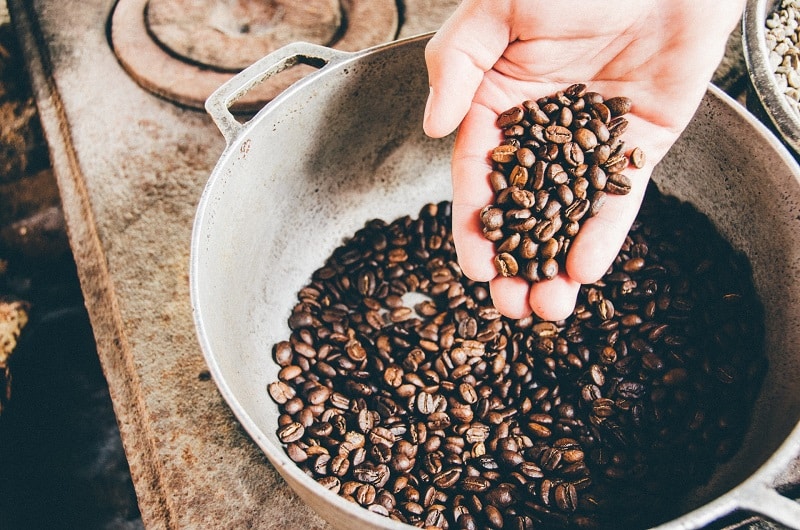
Grinding Beans
Grind size is another major difference that sets espresso beans apart from coffee beans. Espresso beans need to be very finely ground, much finer than coffee beans for brewing regular coffee. This is because the process of making espresso involves hot water being pushed for a short period through tightly packed grounds. The extraction process needs high pressure to do the job well.
Fine grounds also aid in adding pressure to force the water through the coffee and produce a thin layer of tiny bubbles known as ‘crema’. You can make an espresso from a medium-roast coffee bean for example. All you need to do is grind up the beans to very fine espresso quality to achieve the right consistency for brewing espresso.
This is perhaps the most crucial in your venture into using different roasts for espresso. Coarsely ground beans will not produce an ideal espresso. It will usually come out tasting weak or watered down.
Determining the grind size for your coffee beans is equally important in brewing coffee. Coffee tastes vary and adjusting grind sizes to produce the best-tasting coffee out of it will entail some trial and error on your part.
Coffee beans intended for making regular coffee, on the other hand, need only to be coarsely ground. Some brewing techniques for regular coffee take a longer time to brew. That means if the coffee beans are finely ground the result will tend to be over-extracted, bitter coffee. When coffee beans are ground finer, it has more surface exposure.
Coarsely ground light roast, with less surface area, might result in under-extraction. It is generally advised to use a coarser grind setting for dark roasts and a finer setting for light roasts.
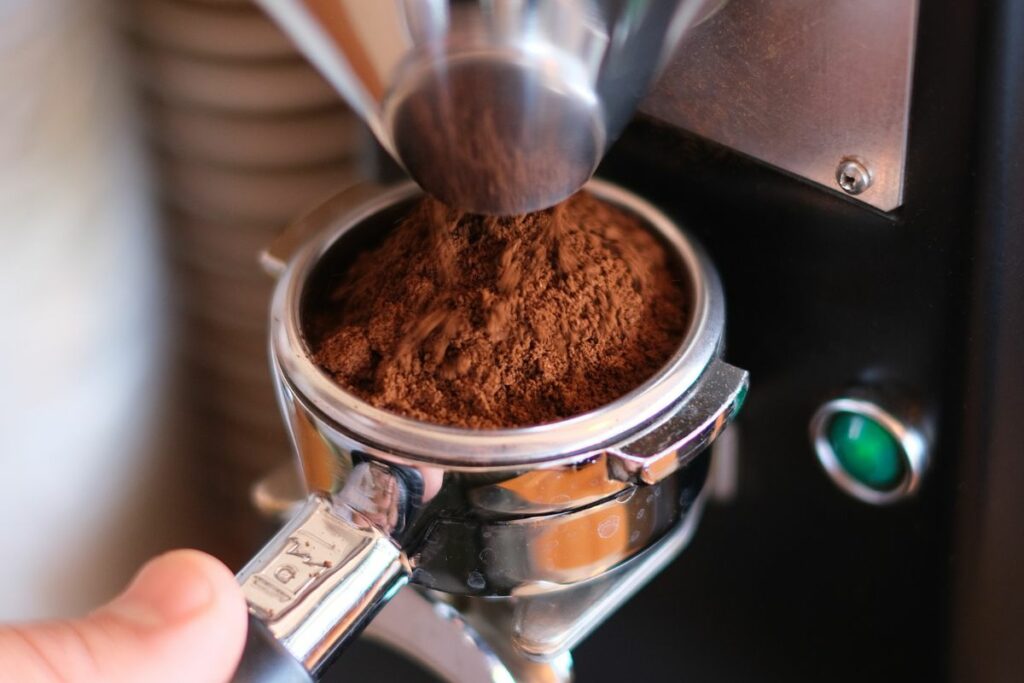
Brewing Beans
Another distinction between espresso beans and coffee beans is the extraction process by which espresso is made. It is important to note that the caffeine levels in roast varieties are pretty much the same. Caffeine level in coffee can vary due to the brewing method used.
Coffee beans are good for brewing coffee using a variety of techniques, and require the use of a coffee machine, French press, drip coffee, percolator, etc. Whether it’s from a standard drip or pour-over method, brewed coffee beans also have less intensity than brewed espresso beans.
Brewing espresso requires a Chemex, an espresso machine, French press, Aeropress, or Moka pot to produce a concentrated and more intense espresso shot. Espresso beans do best with high-pressure extraction techniques, like the former.
Brewing methods that fully immerse coffee grinds lead to a higher caffeine extraction than pour-over techniques. A longer brewing time leads to higher caffeine content, as well. Brewed coffee is also more forgiving in the sense that you can produce standard cups if you can control the extraction process properly.
Learn more about the difference between espresso beans and coffee beans here.
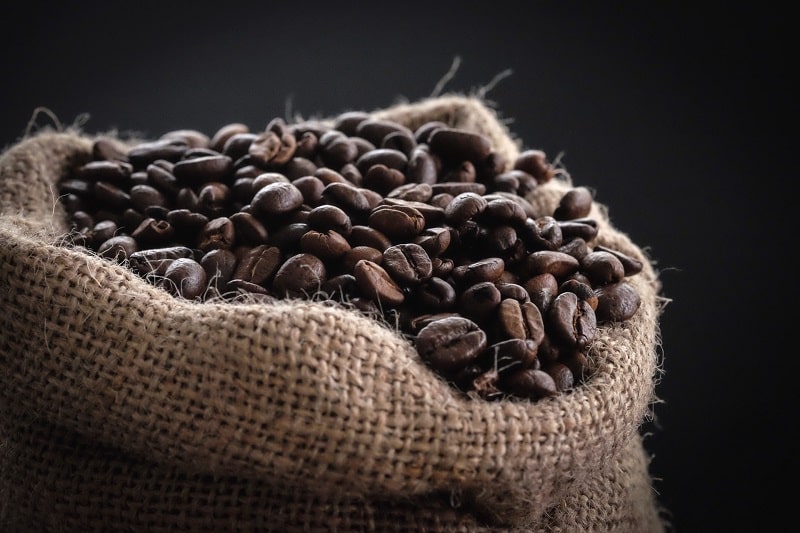
Can You Use Regular Coffee Beans to Make Espresso?
Coffee beans are coffee beans. All coffee beans can be used to make espresso but not all of them will produce that “perfect shot” of espresso. On the other hand, using espresso beans to make regular brewed coffee is fine because espresso beans are simply coffee beans that were just labeled as merely better-suited to pulling espresso.
Making a good cup of coffee is not hard at all. For avid coffee drinkers, making and drinking coffee in the morning is a great way to start the day. Choosing the type of roast to make your perfect cup of espresso is a matter of trial and error. It all boils down to your taste and preference. As they say: different roasts for different folks.
If your morning cup of java calls for a strong perk-me-upper kind of shot, then an espresso shot using espresso beans will surely wake you up. If it’s a slow kind of morning with a leisurely agenda, then a good flat white from medium roast coffee beans sounds about right.
In searching for that perfect roast, there are three color categories to look out for – light roasts, medium roasts, and dark roasts.
Espresso is not a roast but a process of extracting coffee from hot water that passes through finely-ground coffee beans. When ground coffee beans are put under pressure, the result is a much more intense flavor. The espresso label seen on the packaging is simply a coffee bean that is roasted more and has been ground finer (if selecting ground espresso beans).
The label “espresso” suggests to the consumer that the coffee beans have been carefully crafted to suit an espresso-making process. Espresso roast usually belongs to the dark roast color category, and is meant to hold up against high-pressure brewing methods, meant to create a rich crema.
Crema is that light-colored layer that forms on the surface of brewed coffee during the extraction stage.
Espresso does have a higher concentration of caffeine per ounce. A shot of espresso (equivalent to an ounce) is normally 8-10 ounces of regular drip coffee. So that’s a 1:8 or 1:10 espresso-to-drip coffee caffeine ratio.
Espresso has a distinct flavor compared to drip coffee. It is much bolder with a full-bodied finish. It has a less acidic taste and produces a “stronger” but well-balanced coffee flavor.
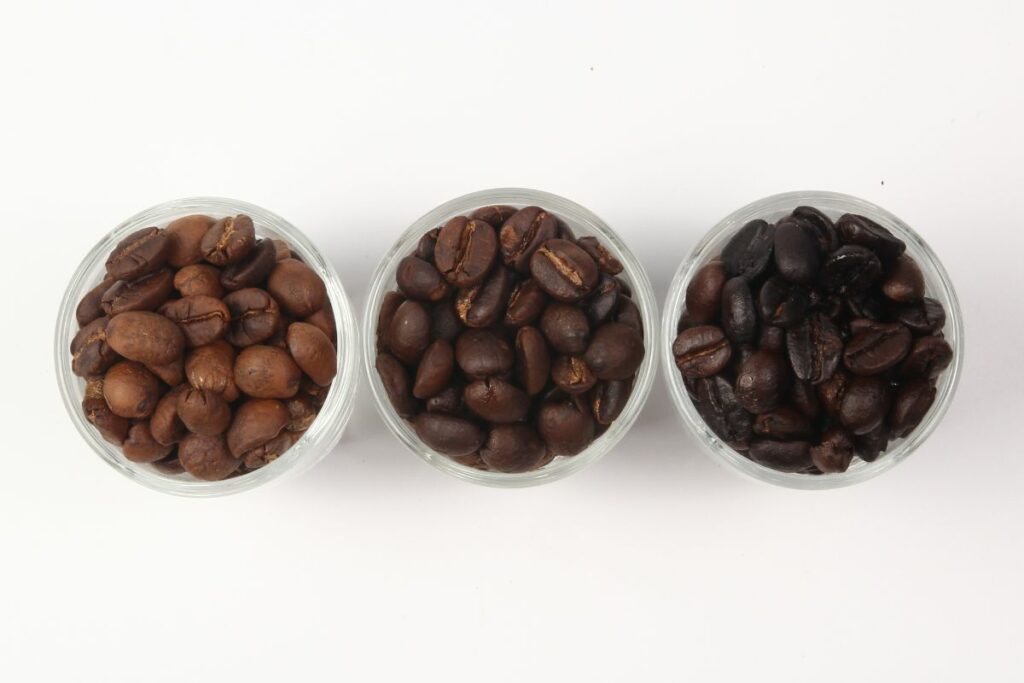
Espresso Roast vs. Light Roast Coffee
Espresso beans are roasted for much longer than light to medium roasts, so most of the caffeine is burned away during this process. This makes a light roast or medium roast coffee more caffeinated than espresso because the caffeine has not had the chance to be exposed to heat. The same is true for acidity; light roast coffee has more acidity than espresso roast.
Light roast has the mildest but most varied depth of flavor all in one. If you want to experience the nuances of flavors and aromas that coffee offers, light roast is your best option. Light roast coffees generally offer floral and fruity flavor notes. They range from a light brown to a cinnamon color, that’s not oil on the surface.
The origin of the beans is most distinct in light roasts. Retaining the full flavor of the beans may not necessarily make a good cup of espresso compared to espresso beans. It will usually lack the intensity and strong bitter taste associated with espresso, and when used, is known as a ‘blonde espresso’. They also tend to have higher caffeine concentrations and acidity due to the shorter roasting time, because both have not had enough time to burn off.
Espresso Roast vs. Medium Roast Coffee
You can definitely use medium roast – medium dark roast coffee beans to make a shot of espresso. The taste will vary depending on the origin. Medium roast coffee will not taste as robust as a dark roast or espresso roast, but it has a balanced flavor profile that many consumers enjoy (myself included!).
Medium roasts have brighter flavors and are ideal for making stronger cups of coffee. Medium brown in color. they’re slightly sweeter than light roasts. They’re known to contain more of the foundational flavors of the coffee, but packaged into a smoother flavor profile.
The farm origin of medium roast beans is significant because this length of roasting brings out the bean’s flavor undertones more than any other. Medium roasts generally offer a balance of a stronger aroma with a pleasing caramel-like sweetness, tapering off the acidity to produce a well-rounded flavor.
Espresso Roast vs. Dark Roast Coffee
A shot of espresso can be made from any roast, but is most often made from dark roast coffee beans. Using dark roast for espresso will yield a bold, strong, and bitter cup of coffee. Dark roast has the most significantly bitter taste among coffee roasts, with a stark dark brown to shiny black color.
This sheen that covers the beans comes from the long roasting process, and is actually a natural coffee oil. Dark roast means the original flavor of the beans is mostly gone, but doesn’t mean that flavor has been compromised. Instead, there is less acidity coupled with a more intense sweetness like chocolate or molasses with spicy, woody, or earthy notes—
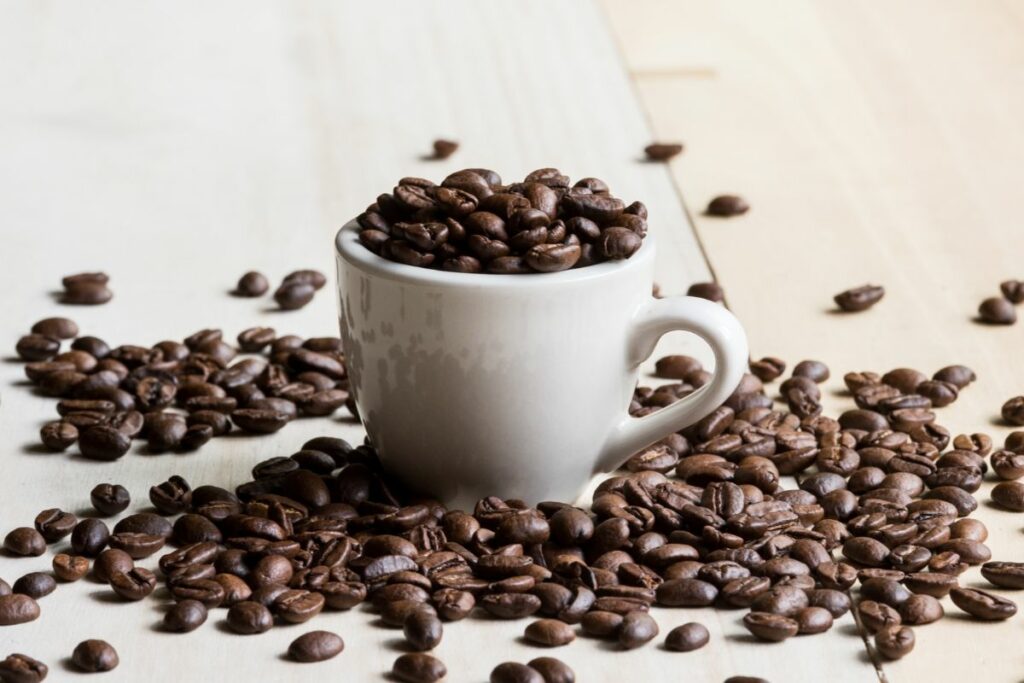
How to Pick a Coffee Beans for Espresso
Here are some things you should consider when picking out a bag of coffee beans from the store:
Origin.
If the coffee packaging doesn’t specify where it was grown, it’s probably not a good option. Put it back down. Specialty coffee will clearly state the country and region (or estate) of origin. Single-origin beans typically have more delicate flavors.
Buy Fresh Beans.
Look out for the freshness of coffee beans or when the beans were roasted on the packaging. Making coffee from beans roasted a couple of days ago will always be better than beans that have been stored for over a month.
Coffee beans in sturdy, vacuum-sealed bags often stay fresh longer than those packaged differently. The roast date is one of the most important pieces of information you should check on the bag. Coffee beans are best used within two weeks of roasting.
Type of roast.
Picking a roast is the first step to ensuring you get a great cup of coffee. The best coffee beans come from freshly roasted (two weeks), whole beans, transparently labeled and ethically grown. Roasting sets apart espresso beans from coffee beans.
Not all coffee beans are able to withstand the high pressure needed to extract an espresso shot, so choose a type of roast that will serve your taste and purpose. If you are making espresso, best to stick with the espresso roast. If you want a milder but more pronounced variety of flavors in your coffee, choose a light roast coffee bean.
Whole or ground.
Choose whole beans instead of ground beans, so that they can be freshly ground as needed. If you do select the latter, you will also no longer be able to manage the grind size for your brewing method of choice.
Quantity.
Purchase coffee beans that you can consume within a maximum of two weeks.
In pursuit of your perfect cup of coffee and to enhance your coffee experience, it’s fun to dive into the world of coffee to understand the semantics of the different coffee labels and roasts. The difference between espresso and coffee beans is not in the actual beans themselves, but in the way coffee is prepared – from roasting to grinding to brewing. In that sense, there’s no right cup of coffee; it should be what’s right for you.